
About UsThe Numismatic Bibliomania Society is a non-profit organization promoting numismatic literature. For more information please see our web site at coinbooks.org SubscriptionsThose wishing to become new E-Sylum subscribers (or wishing to Unsubscribe) can go to the following web page link MembershipThere is a membership application available on the web site Membership Application To join, print the application and return it with your check to the address printed on the application. Membership is only $15 to addresses in the U.S., $20 for First Class mail, and $25 elsewhere. For those without web access, write to: David M. Sundman, Secretary/TreasurerNumismatic Bibliomania
Society AsylumFor Asylum mailing address changes and other membership questions, contact David at this email address: dsundman@LittletonCoin.com SubmissionsTo submit items for publication in The E-Sylum, just Reply to this message, or write to the Editor at this address: whomren@coinlibrary.com
BUY THE BOOK BEFORE THE COINYou won't regret it! |
- WAYNE'S WORDS: THE E-SYLUM JULY 31, 2011
- NEW BOOK: 2012 NORTH AMERICAN COINS & PRICES
- THE BRASHER BULLETIN GOES ELECTRONIC
- ON WORLDWIDE REPLACEMENT NOTES
- THE OSBORNE COINAGE COMPANY OF CINCINNATI, OH
- QUERY: NATIONAL COIN ALBUM PATENT INFORMATION SOUGHT
- NOTES FROM E-SYLUM READERS: JULY 31, 2011
- ARTICLE HIGHLIGHTS COIN DESIGNER HEIDI WASTWEET
- QUERY: VICTOR DAVID BRENNER FOOTBALL MEDAL INFORMATION SOUGHT
- WHO MADE THAT PENNY? VICTOR DAVID BRENNER
- MORE ON CAPTAIN BLIGH'S MEDALS
- BALDWIN'S PROSPERO COLLECTION OF GREEK COINAGE SALE
- THE NUMISMATIC MUSEUM OF ATHENS
- HONG KONG BANKNOTE RECALLED DUE TO DESIGN ERROR
- SECURENCY BANKNOTE SCANDAL AFFECTS PLANS IN THE U.K. AND U.S.
WAYNE'S WORDS: THE E-SYLUM JULY 31, 2011

Among our new subscribers this week is Jim Glickman. Welcome aboard!
We have 1,442 email subscribers, plus 156 followers on Facebook, including Kathy Lawrence.
Shorter issue this week. I'm on vacation with my family and Bruce Perdue is sending this out for me tonight. I'll be out all week so please be patient awaiting email replies. Our next issue will be a first for The E-Sylum - a "Best-of" issue. OK, reruns. But you'll like it. We've published some great stuff over the years.
Have a great week, everyone!
Wayne Homren
Numismatic Bibliomania Society
NEW BOOK: 2012 NORTH AMERICAN COINS & PRICES
 The twenty-first edition of North American Coins & Prices is now available from Krause Publications.
The twenty-first edition of North American Coins & Prices is now available from Krause Publications.
Featuring coin listings and prices for the United States of America, Canada and Mexico, North American Coins & Prices is a handy 3-in-1 guide for coin collectors specializing in the coins of North America. It is also a great starting point for collectors looking to expand their collections into New World issues, or to expand their horizons within current North American issues.
Boasting an expanded listing of Canadian coins reaching back to 1858, this guide also contains information on Mexican coinage from 1701 to date, while the United States listings reach from early 17th and 18th century Colonial tokens and coins to date.
Recent increases in the price of precious metals worldwide have drastically affected coin prices, and almost every coin with gold or silver content experienced significant changes in value that are reflected in 2012 edition of North American Coins & Prices.
With over 47,000 listings organized by country, date and denomination, North American Coins & Prices includes many helpful picture references for the coins listed within its pages.
The 2012 edition of North American Coins & Prices is available at bookstores, and online at http://www.shopnumismaster.com/product/2012-north-american-coins-prices-x9708/us-coins.
Interested retailers should visit http://www.sellcoinbooks.com/us-coin/2012-north-american-coins-prices-20th-edition-a-guide-to-u-s-canadian-and-mexican-coins for more information.
THE BRASHER BULLETIN GOES ELECTRONIC
Dear S.P.P.N. Members:
Recently, we have made the decision to change the format of our newsletter. This decision was made based on production costs, as well as member feedback from the survey in February 2011. Starting this fall, the Brasher Bulletin will become a monthly e-newsletter delivered via email. Each issue will consist of a standout article or news item, as well as information about club news & events. This new format will allow us to stay more connected with all of you while mitigating the high cost of a printed newsletter. Additionally, this allows us to maintain a low annual membership dues fee.
Each year, we will compile all of the monthly e-newsletter issues to produce one printed volume, which will be mailed out prior to the annual meeting at the Summer ANA World's Fair of Money.
Please send your current email address to info@kagins.com, so you will be sure not to miss our monthly articles!
Thank you for your continued support, and please enjoy this last quarterly printed issue of the Brasher Bulletin.
Lena Taylor adds:
As far as the details of the decision, it was really about picking an alternative to the costly print newsletter. We surveyed the SPPN members and asked if they would prefer a link to a website or blog, or if they would like an email with an attached PDF to print on their own, or if they would like to read the Bulletin directly from their email. The latter was the most popular choice with the membership so we went with that.
I spent considerable time researching e-newsletter services and software. We wanted something with different templates that could easily be designed for little to no cost. MailChimp.com and iContact.com were our final choices and we went with iContact.com since they have a free version (send up to 2,000 emails to up to 500 addresses each). This service is not fancy, but flexible enough that we can include one feature with announcements and we can continue our advertising program with banner ads and links to advertisers websites.
THE BOOK BAZARRE
ON WORLDWIDE REPLACEMENT NOTES
Joe Boling writes:
On the subject of worldwide replacement notes, Larry Parker published a book on same that went through at least two editions (1989, 1992), plus several lengthy fixed price lists that also served as catalogs. I donated five of his titles/lists to the ANA library about ten years ago. I'm not sure how they would have cataloged the lists, but whatever they have is available to any ANA or IBNS member to borrow.
David Klinger writes:
Here is a pretty complete summary from Banknote Express: www.banknoteexpress.com/replacements.html
To read the earlier E-Sylum article, see: HELP SOUGHT FOR UPCOMING BOOK ON REPLACEMENT NOTES (www.coinbooks.org/esylum_v14n30a04.html)
THE OSBORNE COINAGE COMPANY OF CINCINNATI, OH
John Byars writes:
I really enjoyed the weekly E-Sylum. Looks like you have the Ingle question well covered. I would like to tell you a little more of what I have been told over time in regards to the Ingle ledger, as it is interesting.
The ledger that Jack Siles originally got, came from the Osborne Coinage Company, Cincinnati, OH. It is a "customer" ledger and covers the Ingle and Insurance Credit System customers, order numbers, and locations the tokens went to. Jack lives there and was volunteering on the local Bloodmobile late 2002 or early 2003, when it went to the company on a blood drive. He met the owner and was offered a tour at a later date.
The company is very high security as they then and now make casino chips, so he was very lucky to get in. He saw many things on his visit and he was able to visit the older buildings. They trace their lineage way back with the various companies buying out each other. Evidently the company "stock" moved along to each new company.
They have dies that go back before the civil war and even a large Presidential Washington or Lincoln die. Also loose tokens are in with the merchant token dies. This is according to what an employee told me. They showed Jack a stack of old dusty ledgers, and he said one was a Murdock ledger. He came to the Ingle / ICS ledger and they let him copy it. He did the A, B, & Cs by hand before finally getting to a machine. After Jack got his copy, I called Osborne to try and see if I could get a copy. They told me in "no uncertain terms" that they did not have any old token ledgers. Other ledgers that I know of and hope they still have, covered the red and blue OPA tokens, all the various cutouts used on tokens, Osborne Register Co., and I believe ISC.
I sure wouldn't want to make any waves at Osborne, but if I was there in Cincinnati, I sure would try to make some friends. Those ledgers, walls of cubby holes of dies and tokens - INGLES, ICS, etc., are things you dream of getting into. I hope they won't be hounded by folks wanting to get inside now, but like I said, if I was there I would sure diplomatically try myself. They even have a bunch of the old token cash register parts, or did at least 10 years ago.
I am told that about 40 - 50 years ago a collector doing coal script listings got in there and had a great time. Maybe somebody well known, such as David Schenkman can someday get in there for his mining company research. From what I am told it will be after the top man retires, if he hasn't by now, as the young folks will be easier to deal with.
I did ID some Ingles for Steve Tanenbaum in Jan 2008, but I only make an offer if asked to do so. No strings attached - I enjoy the identifying part.
To read the earlier E-Sylum article, see: MORE ON INGLE SYSTEM SCRIP (www.coinbooks.org/esylum_v14n30a17.html)
QUERY: NATIONAL COIN ALBUM PATENT INFORMATION SOUGHT
I've hit a roadblock in my research into coin albums, and I'm appealing to readers who may be able to assist.
M. L. Beistle's 1929 patent number 1,719,962 on what later became the Wayte Raymond National Coin Album is easy to locate at the U. S. Patent Office's website, www.uspto.gov., but the site is complex enough that I was not able to determine whether this patent was ever renewed or reassigned to another party. Perhaps an E-Sylum reader can determine this and provide me with some answers.
THE BOOK BAZARRE
NOTES FROM E-SYLUM READERS: JULY 31, 2011
Theophilus Bradbury;s Hallmarks
Regarding the hallmarks of silversmith Theophilus Bradbury, Mike Packard writes:
I agree that the punches on the silver piece are slightly different from the punches Bradbury used on the silver pieces I've seen. However, that does not mean that Bradbury did not create the punches on the coin. They might have been early (or possibly late) efforts, I'd need to see many more pieces of Bradbury's silver to ensure he did not use more than one pair of punches. To my eye, the punches on his silver utensil are more refined than those on the coin.


To read the earlier E-Sylum article, see: MORE ON THE HALLMARKS OF THEOPHILUS BRADBURY (www.coinbooks.org/esylum_v14n30a12.html)
Trillion-Dollar Coins Proposed
Len Augsburger writes:
Let me be the first of many to mention this for The E-Sylum.
We are having a debt-ceiling crisis because Congress has given the president contradictory commands; it has ordered the president to spend money, and it has forbidden him to borrow enough money to obey its orders.
Are there other ways for the president to raise money besides borrowing? Sovereign governments such as the United States can print new money. However, there's a statutory limit to the amount of paper currency that can be in circulation at any one time.
Ironically, there's no similar limit on the amount of coinage. A little-known statute gives the secretary of the Treasury the authority to issue platinum coins in any denomination. So some commentators have suggested that the Treasury create two $1 trillion coins, deposit them in its account in the Federal Reserve and write checks on the proceeds.
To read the complete article, see: 3 ways Obama could bypass Congress (www.cnn.com/2011/OPINION/07/28/balkin.obama.options/)
ARTICLE HIGHLIGHTS COIN DESIGNER HEIDI WASTWEET
At least during their lifetimes. But coins live on and on, and someday future collectors will come to appreciate the accomplishments of today's "worker bees". These local newspaper articles publish some of the best information we'll ever have on many of the designers of our coins and medals. -Editor
 In the rundown basement of Seattle's former Immigration and Customs Enforcement building is the studio of Heidi Wastweet, a 42-year-old sculptor who believes coins are exchangeable art.
In the rundown basement of Seattle's former Immigration and Customs Enforcement building is the studio of Heidi Wastweet, a 42-year-old sculptor who believes coins are exchangeable art.
Foot-long circular plaster casts of coins, etched with the faces of historic American heroes, are propped against a corner. Translucent paper tracings of portraits lie scattered on a worktable. Wastweet's prized commissions — a currency coin for the Darfur region of Sudan, the Dean's Award for the University of Washington law school, a replica of the 1964 peace dollar — glint from a wooden shelf.
Wastweet is a Seattle sculptor and medallic artist, but one of her passions is to design money — coins, specifically. Wastweet began designing coins when she was 18 at a private mint in Idaho, then switched to a different mint based in Las Vegas before going freelance. Since the late 80s, Wastweet has created more than 1,000 coins, medals and tokens.
Coins have defined the majority of Wastweet's past, and now she gets to design the future of the United States' coins. Wastweet was appointed in March last year to the Citizens Coinage Advisory Committee, an unpaid 11-member panel that reviews the work of the U.S. Mint and advises the Treasury about what designs make it onto the billions of coins circulated throughout America each day.
Coins may be viewed as chump change, says Wastweet, but the image on a penny, nickel or quarter can influence the way we and the world view America.
"What's the one thing that every single tourist from all around the world touches when they come to the United States?" asked Wastweet. "It's our coins. If we have mediocre artwork on our coins, that leaves an impression on those visitors of a mediocre country, because art is the ultimate sign of a civilization. When a civilization is advanced enough to support its arts, it's at its height."
Wastweet thinks that the U.S. is behind the times — behind Canada, the European Union and Britain — when it comes to our coins. We're stuck in a rut of antiquated classical designs, says Wastweet, and there's been little coinage innovation because America doesn't view its currency as a work of art.
"In France, the sculptors at the mint are treated like rock stars," she said. "They're celebrities. But here they're treated like little worker bees down in the basement."
The U.S. Mint has 15 coin artists in its Artistic Infusion Program, a citizen-based stable of artists, and seven in-house sculptors. They are taking assignments to design about 50 new coins this year, said Wastweet.
Wastweet's vision is for America to create coins suitable for the current time, while still reflecting our historic past. But is the time for coins gone, as more and more people switch to credit cards and debit cards in a digitized world?
Not anytime soon, says Wastweet.
"There will always be a place for cash as long as there are illegal drug deals, garage sales and people on Craigslist buying things on a one-to-one basis," she said. "We'll always have coins."
To read the complete article, see: Seattle sculptor wants to mold U.S. coin making into an art form (seattletimes.nwsource.com/html/localnews/2015719508_coins25m.html)
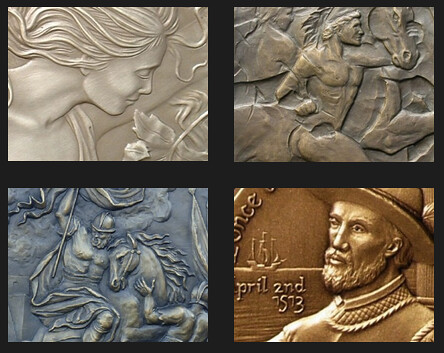
To visit Wastweet's web site, see: www.wastweetstudio.com
Roger Burdette adds:
Sculptor Heidi Wastweet is one of America's most perceptive and talented artists working in medallic art. I have had the pleasure of knowing her since 2001 and have enjoyed the depth of commitment and clarity of depiction in her private and commissioned work. She treats every commission as new and fresh, bringing both creative and practical insight to the result.
I was very pleased to have her join the CCAC early last year and the Committee has benefited greatly from her professional talent and judgment. Heidi was, along with me and two other CCAC members, part of a subcommittee that conducted a comprehensive investigation of the US Mint's coinage design process. The subcommittee's recommendations, published in January 2011, presented the first coherent plan for improvement of the artistic quality of America's coins and medals since the gold coin redesign commission issued to sculptor Augustus Saint-Gaudens in 1905.
Heidi is also a medallic artist who understands the mechanics and limitations of coinage, both on the small scale of commemoratives and the mass production required for commerce. She is open minded and willing to listen to others, yet firm in her knowledge of creative art and all its nuances.
I have nothing but praise for Heidi Wastweet's work and for her contributions to the CCAC.
QUERY: VICTOR DAVID BRENNER FOOTBALL MEDAL INFORMATION SOUGHT
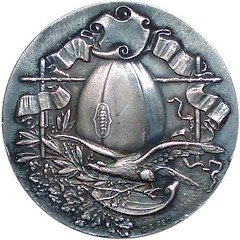
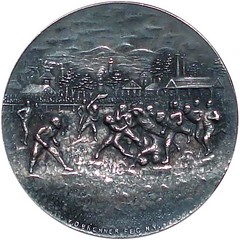
In celebration of a season saved this week... I thought I'd share pictures of this medal and ask if anyone had more information about it.
This is a rather small (35 mm) silver medal produced by Victor D. Brenner. It is cataloged as Smedley 15... and that's about all I know. Most of Brenner's medals are works of portraiture. This one, clearly, isn't. This medal shows a highly detailed football game, with at least 16 players represented (I'm having a hard time counting heads, even with the medal in front of me), including one of the players nearly upside down in the scrum, plus a referee waving a flag in the middle.
After some digging, I finally found another auction appearance for this one, in the July, 1993, Presidential sale, where a white metal specimen was sold as lot 334. Unfortunately, that listing only had a description of the medal itself, with nothing of the history behind it. (It also suggests that they could find only one other modern auction appearance to that date, of an electrotype in the 1978 NASCA Irwin Stoff Sale, which I don't have.)
Could anyone share some history of why Brenner produced this medal that is so atypical of his other works?
WHO MADE THAT PENNY? VICTOR DAVID BRENNER
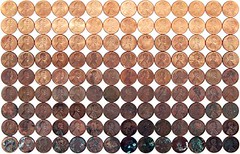 The penny is a neglected coin. Frequently orphaned on the street. Mercilessly taunted for its mediocrity. In an age of trillion-dollar debt and billion-dollar bank bailouts, America's lowest common denomination seems to bear little value as an individual monetary unit. Yet the copper-toned coin bearing Lincoln's profile still holds a unique place in our national identity. Phrases like Benjamin Franklin's "A penny saved is a penny earned" and the actual artifact itself (shown above is a photographic penny spectrum by the designer Bob Dinetz,) are as American is it gets. The same cannot be said of the origins of its designer.
The penny is a neglected coin. Frequently orphaned on the street. Mercilessly taunted for its mediocrity. In an age of trillion-dollar debt and billion-dollar bank bailouts, America's lowest common denomination seems to bear little value as an individual monetary unit. Yet the copper-toned coin bearing Lincoln's profile still holds a unique place in our national identity. Phrases like Benjamin Franklin's "A penny saved is a penny earned" and the actual artifact itself (shown above is a photographic penny spectrum by the designer Bob Dinetz,) are as American is it gets. The same cannot be said of the origins of its designer.
The head face of the Lincoln cent, first minted in 1909, was designed by Victor David Brenner.
Larry Eisenberg of New York City wrote:
Victor Brenner deserves hearty cheers,
His Lincoln cent lasted for years,
Though I don't have many
I cherish the Penny,
Though badmouthed, it still perseveres.
To read the complete article, see: Who Made That Penny? (6thfloor.blogs.nytimes.com/2011/07/26/who-made-that-penny/)
MORE ON CAPTAIN BLIGH'S MEDALS

Two gold medals earned by Captain William Bligh during his exploits at sea during the late 1700s are to be auctioned in Australia and are expected to fetch more than AU$250,000 (£165,000).
Captain Bligh, who is best known for being ousted from his post aboard the HMS Bounty by a mutinous crew, won the medals during his long and distinguished career in the Royal Navy. The medals themselves, which have been handed down by Capt Bligh's descendants for generations, have been described as "extremely rare", but it is their association with the renowned seafarer that lends them special value.
Capt Bligh was on a mission to bring back breadfruit, which the British empire hoped it could cultivate to feed to slaves in the West Indies, in 1789 when the famous mutiny took place and he and a group of his men were set adrift in a 22ft launch without navigation equipment in the middle of the Pacific Ocean.
In a remarkable feat of endurance, the celebrated British seaman and his crew spent 47 days at sea, catching fish and seabirds and drinking rainwater to survive while navigating thousands of nautical miles by memory.
After eventually making land in West Timor, Capt Bligh returned to Britain, where he was subject to a Court Martial over the loss of the Bounty. He later returned to seafaring and went on to be appointed Governor of New South Wales in Australia.
He won the first medal, estimated to be worth AU$50,000 (£30,000) from The Society for the Encouragement of Arts, Manufactures and Commerce when he finally completed his original mission and succeeded in bringing breadfruit back from Tahiti in 1794.
The other medal, named the Naval Gold Medal 1795, was awarded in recognition of his actions during the successful 1797 Battle of Camperdown against the Dutch, in which the British fleet captured 11 Dutch vessels without losing any of their own.
To read the complete article, see:
Rare Captain Bligh medals to be auctioned in Australia
(www.telegraph.co.uk/news/worldnews/australiaandthepacific/
australia/8659234/Rare-Captain-Bligh-medals-to-be-auctioned-in-Australia.html)
Jim Duncan of New Zealand adds:
The Captain Bligh small naval gold medal awarded to Captain William Bligh for his part in the Battle of Camperdown, October 1797, sold in Noble's latest auction for A$216,000 +. TheSociety of Arts gold medal given to Bligh for taking a bread fruit tree to the West Indies in 1794 went for A$116,000 +, and pieces of silver cutlery engraved W-E-B (William and Elizabeth Bligh) went for A$5,100 = .
The WW2 Victoria Cross to Aussie Ted Kenna, won in New Guinea in 1945, sold for A$1,002,000 +. This was all on Thursday 28 July.
Anna Bligh, the current Premier of the State of Queensland, is a direct descendant.
BALDWIN'S PROSPERO COLLECTION OF GREEK COINAGE SALE
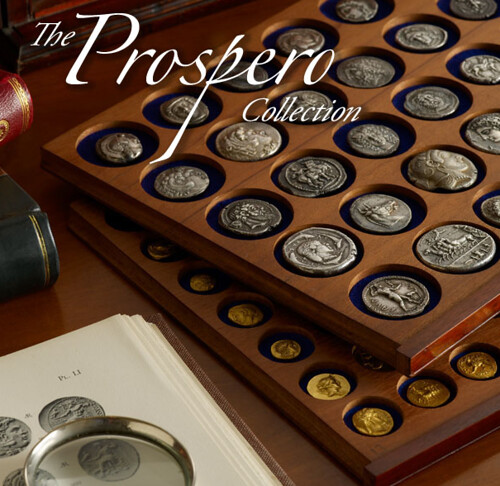
Baldwin's are delighted to announce the sale of one of the finest and most desirable collections of ancient Greek coins to be offered at public auction in the last two decades. The multi-million pound Prospero Collection contains over 600 coins from the Archaic, Classical and Hellenistic Greek periods and includes some of the rarest and most historically important examples of Greek coinage. Offering a unique window into a world of epic history and a wonderland of Greek mythology, this collection is sure to inspire collectors from all walks of the art and antiques world.
The collection was formed over several decades by a collector with a passion for the arts and a discerning taste for outstanding examples of the most beautiful and famous ancient Greek coins. Like the character of Prospero in Shakespeare's The Tempest, an underlying preoccupation for the magical and mythical can be seen throughout the collection. It has not been added to in the past 20 years and remains complete and untouched, with many of the coins having pedigrees dating back to collections dispersed in the early 20th century.
The artistic beauty of ancient Greek coins has never been equalled by any other civilization and The Prospero Collection contains masterpieces from the 6th – 3rd century BC, all of the very highest Archaic and Classical artistry, created by the most famous artists and engravers of the time. Greek gods and goddesses bustle with each other and compete with mythical creatures and Greek heroes to be represented on these sublime miniature works of art. Within the collection the coins of ancient Sicily, particularly those produced at Syracuse, represent the very pinnacle of the die-engravers art.
There are examples of the Dekadrachm of Syracuse, among the largest and most famous of all ancient Greek coins, including a signed example, struck from the very first pair of dies engraved by the artist Kimon. The famous ‘Demareteion' Dekadrachm, considered to be one of the most beautiful creations of fifth century B.C. numismatic art, is also represented. The artist who created this coin is considered to be one of the greatest master-engravers of the Archaic and Classical periods.
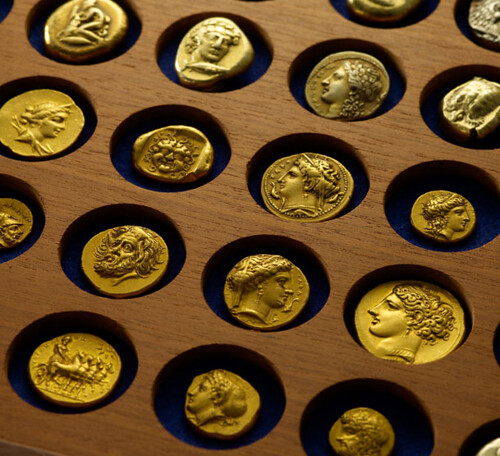
"HOW TO SUCCEED IN NUMISMATIC PUBLISHING. . . ."
THE NUMISMATIC MUSEUM OF ATHENS
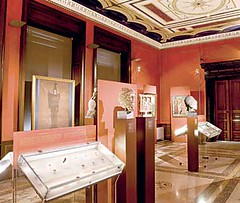 While the riddle of the Greek debt dominates conversations, temperatures are rising and the atmosphere on Panepistimiou Street in central Athens is decidedly stuffy.
While the riddle of the Greek debt dominates conversations, temperatures are rising and the atmosphere on Panepistimiou Street in central Athens is decidedly stuffy.
But here's a chance to change your mood and take a journey back in time. The year is 1881, when German architect Ernst Ziller built a marvelous residence, known as the Iliou Melathron, for his friend, the archaeologist Heinrich Schliemann.
Inside the restored building which now houses the Numismatic Museum of Athens, you can picture the day when elegantly dressed members of high society would gather on the mansion's arched terraces to admire floor mosiacs made by Italian artisans and walls covered by murals depicting scenes of life in Pompei. All around the building were elegantly decorated ceilings, including the residence's master bedrooms -- the private quarters of Schleimann and his spouse, Sophia Engastromenou, 30 years his junior and whose marriage to the German expatriate had been the result of matchmaking.
The building -- which at the time of its construction had cost the formidable sum of 439,650 drachmas -- became a point of reference for the city's social and cultural life all the way up to the beginning of 20th century. It was sold to the Greek state in 1926 and subsequently housed the Supreme Administrative Court and the Supreme Court.
Every Tuesday at noon, the Numismatic Museum offers history lessons through the prism of money and its myths, but also on the mansion and its celebrated residents.
In the meantime, the museum's upcoming temporary exhibition, "The Cost of Nutrition," will focus on the prices of products from antiquity to the present. Afterward, it will travel to the Museum of the History of Cypriot Coinage, which is housed at the Bank of Cyprus in Nicosia, in February next year.
Back in Athens, the Numismatic Museum is also preparing for the display of the so-called Abdera Hoard, a rare collection of ancient coins which were repatriated following a donation by an American collector who had purchased the items in New York in 2000. This exhibition is expected to open in November.
To read the complete article, see: History and beauty lessons at the Numismatic Museum (www.ekathimerini.com/4dcgi/_w_articles_wsite4_12906_25/07/2011_399801)
HONG KONG BANKNOTE RECALLED DUE TO DESIGN ERROR
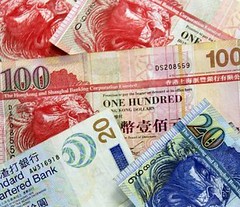 HSBC Hong Kong on Monday apologised for printing a batch of flawed HK$100 ($12.8) notes depicting the petals of the Bauhinia flower -- the city's emblem -- pointing in the wrong direction.
HSBC Hong Kong on Monday apologised for printing a batch of flawed HK$100 ($12.8) notes depicting the petals of the Bauhinia flower -- the city's emblem -- pointing in the wrong direction.
HSBC is the largest banknote issuer in the southern Chinese city accounting for around 65 percent of those in circulation, according to the Hong Kong unit of the giant British banking group.
The bank said it "sincerely apologises for the embarrassment caused to all parties concerned" but emphasised none of the bank notes have been circulated, a spokeswoman at HSBC Hong Kong told AFP.
She added the bank would fix the problem as soon as possible but did not say how many flawed notes had been printed or the cost involved in redesigning and reprinting the notes.
The bank and the city's government had failed to detect the flaw before unveiling the new designs last Friday, but the mistake was highlighted in local media over the weekend.
In a statement issued late Sunday, the government also apologised for the error and said HSBC had started redesigning and reprinting new HK$100 banknotes, with a plan of putting them into circulation early next year.
To read the complete article, see: Flawed Hong Kong dollar notes embarrass bank
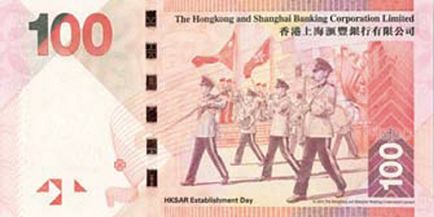
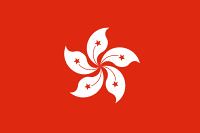 According to an article in The Standard dated 25 July 2011, the Hongkong and Shanghai Banking Corp has admitted to
making a mistake in the design of its new 100-dollar (US$12.85) note which was officially unveiled on 20 July and
slated for issuance between November 2011 and January 2012. The back of the note depicts the flag-raising
ceremony of the SAR Establishment Day with a marching band playing in front of the Golden Bauhinia Square,
where the national flag and regional flag of Hong Kong are flying. The problem is that the bauhinia flower on the
regional flag is reversed from the correct orientation shown here:
According to an article in The Standard dated 25 July 2011, the Hongkong and Shanghai Banking Corp has admitted to
making a mistake in the design of its new 100-dollar (US$12.85) note which was officially unveiled on 20 July and
slated for issuance between November 2011 and January 2012. The back of the note depicts the flag-raising
ceremony of the SAR Establishment Day with a marching band playing in front of the Golden Bauhinia Square,
where the national flag and regional flag of Hong Kong are flying. The problem is that the bauhinia flower on the
regional flag is reversed from the correct orientation shown here:
To read the complete article, see: Hong Kong's new 100-dollar note has a design error (banknoteupdate.com/files/492ed793264e6203d10d0c2e108115c7-1630.php)
SECURENCY BANKNOTE SCANDAL AFFECTS PLANS IN THE U.K. AND U.S.
 THE Bank of England has cancelled a secret plan to print the £5 banknote on polymer material supplied by a Reserve Bank of Australia subsidiary as the fallout spreads from the international bribery scandal engulfing the company.
THE Bank of England has cancelled a secret plan to print the £5 banknote on polymer material supplied by a Reserve Bank of Australia subsidiary as the fallout spreads from the international bribery scandal engulfing the company.
The Age can also reveal that the American company that supplies the paper material on which the US Federal Reserve prints the greenback has baulked at buying Securency International, which makes polymer banknote substrate, after conducting months of due diligence.
Securency was put up for sale by the RBA in November last year, 18 months after The Age first revealed concerns that the company's payment of millions of dollars to overseas middlemen may have been used to bribe foreign officials.
The Age has learnt the Bank of England was preparing to trial printing of its high-circulation £5 note on Securency's polymer. But it recently overturned the decision because of the criminal charges against the company and its former executives.
Had the deal gone ahead, it could have become Securency's most prestigious contract and also one of its most lucrative. The Bank of England did not respond to questions from The Age.
Securency is half-owned by British company Innovia Films. Britain's Serious Fraud Office is investigating the company for allegedly bribing Nigerian officials to win a series of contracts between 2006 and 2009.
Securency paid middlemen involved in the Nigerian deals about $20 million in commission payments, much of which was wired to tax haven locations notorious for their secrecy and use in money laundering.
US paper banknote supplier Crane & Co also recently decided to pull out of the acquisition process for Securency.
To read the complete article, see: Bribery fallout sinks £5-note deal (www.theage.com.au/national/bribery-fallout-sinks-5note-deal-20110727-1i0ej.html)
